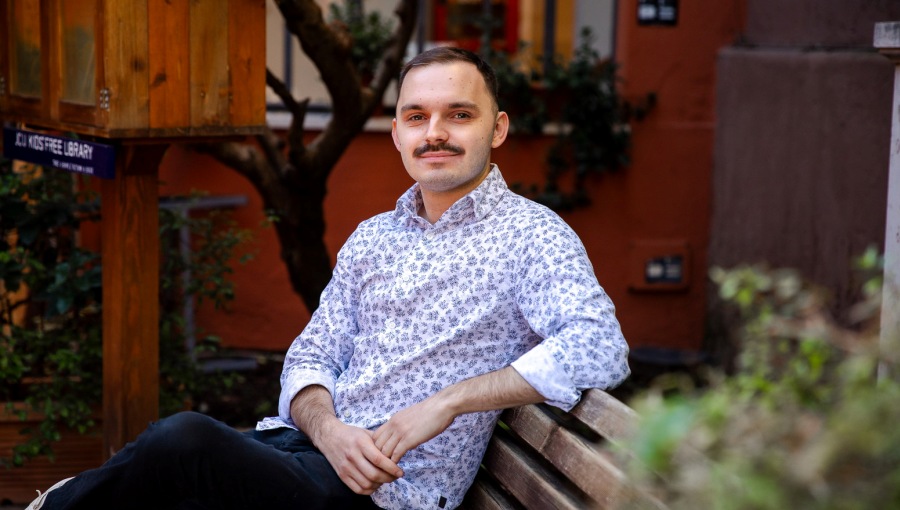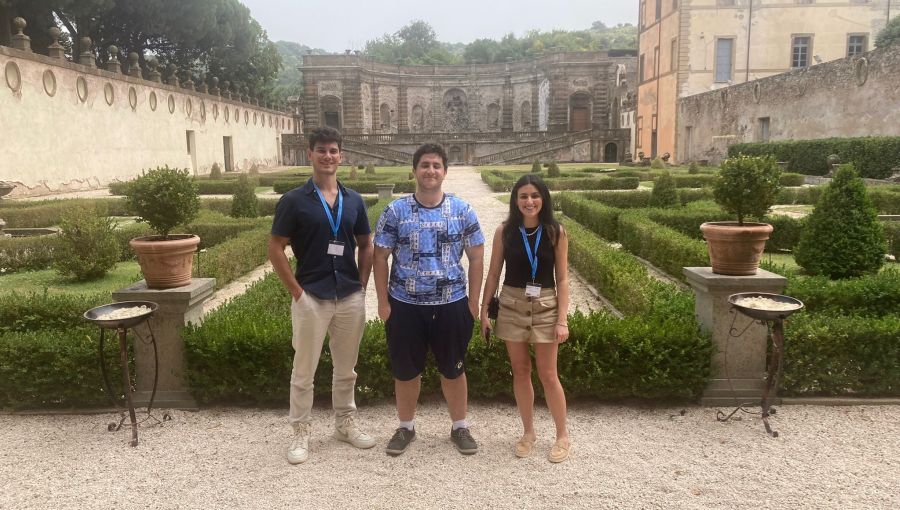A Transformative Experience: MA in Art History Alumnus Gavin Austin Gaebe
Originally from Virginia, alumnus Gavin Austin Gaebe graduated from JCU with an MA in Art History in 2024. He holds a B.A. in History and a B.S. in Journalism from Liberty University in Lynchburg, Virginia. During his time at JCU Gavin worked as Teaching Assistant for Professor Inge Hansen, in her on-site course Ancient Rome and Its Monuments.

How did you find out about JCU’s MA in Art History and what made you decide to apply?
I have spent much of my life in central Virginia but knew after receiving my undergraduate degree in History and Journalism that I wanted to eventually get my Master’s degree in Art History overseas. I was exploring other programs, not necessarily in English, and then I stumbled upon John Cabot University. There, I found the perfect opportunity to study Art History in Rome with professors who teach in English. The quality of education at John Cabot appeared to match what I would have found at an in-state university, but the location in Rome far surpassed anything a US university could offer to those who are interested in the Mediterranean world, such as myself.
My decision to apply was largely based on the University’s unique location in Rome and its approach towards educating an international student body. I was excited by the opportunity to discover Rome on a far deeper level than I had been able to beforehand with my single half-semester abroad in early 2020 and I felt that JCU would be the right fit for me as an institution.
How did you become passionate about Art History?
I can remember even as a teenager asking to visit the art museum or galleries of any given city where my family happened to be traveling. I became fascinated not with one particular era, artist, or medium, but with the broad swath of human creativity and production across the millennia. While my access to art growing up in central Virginia was fairly limited, I developed a strong passion for art history as an academic pursuit during my undergraduate years, where I was able to conduct several research projects even within my B.A. in History program that incorporated my interest in Art History. While my undergraduate university did not offer a bachelor’s in art history, I knew that that was where I wanted my future academic career to eventually take me.
Tell us about your experience as Teaching Assistant. How did this experience enrich you?
My work as a Teaching Assistant involved answering students’ questions about the course material and providing feedback on their assignments. My role provided an additional resource for the students who wanted to succeed in the course and open their minds to find the joy of studying art history in Rome.
Collaborating closely with Professor Hansen was instrumental in refining my pedagogical skills and expanding my knowledge of art history. We had weekly discussions on course material, to identify focus areas and strategize the most effective ways to present content to the students. Through this mentorship, I gained valuable insights into instructional methodologies and was inspired to find my own voice as a potential future educator. Furthermore, Professor Hansen’s guidance was key in devising my own syllabus for a course I would be qualified to teach upon graduating with my MA in Art History.
One of the highlights of my journey as a Teaching Assistant was delivering a lecture to the class later in the semester. This experience strengthened my presentation skills and empowered me to share my passion for art history with the students. All of these aspects made this opportunity well worth my time and energy, as it had a direct impact on my career prospects and academic interests. I would encourage all prospective MA students to seek Teaching Assistant opportunities at John Cabot University, since I have found the experience to be incredibly rewarding.

Tell us about your thesis.
I completed my thesis on the thirteenth century façade mosaic of the Basilica of Santa Maria in Trastevere in Rome, which depicts some enigmatic iconographic elements whose unique combination I attempted to read as a thirteenth-century viewer. In doing so, I used the nearly limitless resources Rome has to offer beyond JCU’s Frohring library, including the American Academy in Rome, the Bibliotheca Hertziana, the Biblioteca di Archeologia e Storia dell’Arte, the Norwegian Institute in Rome, and the International Center for the Study of the Preservation and Restoration of Cultural Property, just to name a few. These libraries and institutions proved invaluable for conducting my extensive exploration into the secondary literature on the façade mosaic. I was also able to take advantage of the connections my professors had to discuss my findings with prominent scholars in the field, such as art historian Dale Kinney, who generously offered invaluable insight. I was surprised to learn that despite Rome being one of the most closely studied cities in the world, there is still much work to be done, much material still to be published in English, and even many still unexplored gems that stir the imagination with interpretive possibilities for the public. I felt this was true of my thesis topic, but also of Rome in general.
What classes and/or professors impacted you the most and why?
Professor Sharon Salvadori’s Visualizing Saints in Late Antiquity and the Middle Ages, c. 300-c. 1300: Gendering Saints in Rome sparked my strong interest in medieval art history and helped bring that relatively underappreciated part of Rome’s history to life in ways that it never was previously for me. The site tours were informative, and Professor Salvadori allowed ample time at each where we could look closely, discuss, debate, and investigate how medieval Romans communicated their beliefs on gender through the religious art of their respective time. The final paper I wrote for that class went on to become my thesis because I found this topic to be incredibly rich in material and fascinating to me as a scholar. In addition to this course, Professor Lila Yawn’s course titled Rome Recycled presented me with a fabulous experience every week where we had the absolute freedom to study nearly any site we wanted and present our findings in a very intimate class while on-site. While the readings and material we covered was undeniably fascinating, I was particularly struck by her deeply comprehensive knowledge of Rome’s history. Allowing us the academic freedom of exploration was, to me, the perfect way for master’s students to explore the city since we are in the position where we need to conduct research at a higher level than the undergraduates.
What are your plans for the future?
Presently, I am continuing to hunt for museum jobs in the United States and I hope to one day work in education or interpretation. Perhaps one day, a curatorial position might be in my future, but for that I will need to get my Ph.D., which will be farther down the line.





